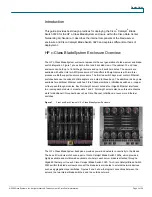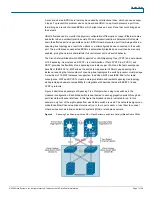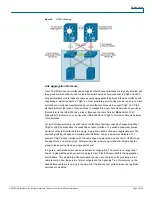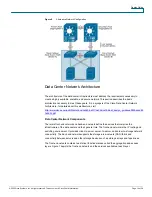
Design Guide
© 2008 Cisco Systems, Inc. All rights reserved. This document is Cisco Public Information.
Page 17 of 28
The Cisco Catalyst Blade Switch 3020 contains an additional Fast Ethernet port, which connects to
the HP c-Class BladeSystem Onboard Administrator, providing OOB management using the insight
manager interface. The user may also use this path to access the CLI functions of the switch,
transfer SNMP information, and upload software images and configuration files. This path is
independent of the switch fabric. This Fast Ethernet port defaults to a Dynamic Host Configuration
Protocol (DHCP) client from a DHCP server either as part of the Onboard Administrator or external
on the network attached to the enclosure. The user can also set a static IP address for the Fast
Ethernet port.
The Cisco Catalyst Blade Switch 3020 supports multiple switched virtual interfaces (SVIs) to be
active at the same time; however, it does not perform any routing functions between SVIs. By
default, the SVI is created as VLAN 1 and enabled during the setup phase of the installation. The
VLAN is often referred to as the “management VLAN”. Cisco recommends that the user change the
management VLAN to something other than VLAN 1. Therefore, it is important to create an SVI
with another VLAN and allow this VLAN on the external front-panel ports. In addition, you can
manage the switch using the Fa0 port using the Onboard Administrator on the back of the
enclosure.
By default, the Cisco Catalyst Blade Switch 3020 provides no routing functions and can have only
one default gateway defined. Even though the Fa0 interface is called “routed”, it cannot route user
traffic. Therefore, if you enable multiple SVIs or enable the Fast Ethernet port, you will not be able
to access all these interfaces from other subnets. The recent migration (12.2(22)SE) of the Cisco
Catalyst Blade Switch 3020 from the LANBase image to IP Base provides basic Layer 3 routing
(RIP and Static Routing and EIRGP Stub).
For best practices in selecting the management VLAN, please visit:
http://www.cisco.com/en/US/products/hw/switches/ps700/products_white_paper09186a00801b49a
4.shtml
.
In-Band Management
In-band management uses logical isolation to separate management traffic from data traffic. VLANs
segregate the two traffic types that are sharing the bandwidth of the uplink ports. This practice is
common in situations in which multiple applications running on the servers must be managed along
with the network infrastructure devices.
In-band management traffic uses the uplink trunk ports located on the back of the Cisco Catalyst
Blade Switch 3020s for management. Cisco recommends that the Data VLANs not be the same
VLAN as the management VLAN.
Serial Console Port
The front panel of the Cisco Catalyst Blade Switch 3020 has an RJ-45 serial port that can be used
to manage the switch through the CLI. The CLI can be accessed by connecting directly to the
console port with the serial port of a workstation or remotely by using terminal servers and IP
connectivity protocols such as Telnet.












































